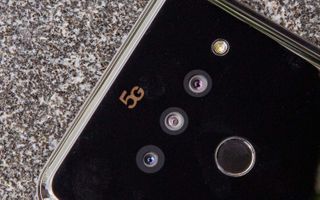These Sprint phones will lose 5G: What you need to know
Did you buy a 5G phone from Sprint last year? Get ready for some bad news

Now that the T-Mobile-Sprint merger has gone through, the real hard work can begin — integration of the two networks. It's a process that will take a few years and, evidently, Sprint's initial batch of 5G phones will not be able to come along for the ride.
In fact, CNET reports that Sprint will not update the 5G phones it released last year — the Samsung Galaxy S10 5G, LG V50 ThinQ 5G and OnePlus 7 Pro 5G — to work on the consolidated T-Mobile 5G network, once Sprint's 5G infrastructure is relaunched later this year.
- What is 5G? The definitive guide to the 5G network rollout
- Best 5G phones: Which device should you buy?
- Plus: Google Pixel Buds 2 launch imminent as retailer posts listing
That's despite Sprint claiming last summer that the Galaxy S10 5G in particular would support whatever 5G networks the merged companies deliver in the future, and despite the fact that both Sprint and T-Mobile heavily touted their merged 5G networks as one of the primary benefits of their union.
Why Sprint's first 5G phones are doomed
The problem, it turns out, is two-fold. First, LG and OnePlus' 5G phones configured for Sprint lack support for T-Mobile's low-band 5G. Rather than allowing those customers to continue using the mid-band part of T-Mobile's overall 5G network, it seems like the company would rather push them toward a new 5G device through reduced pricing — more on that in a moment.
The other issue is that, ironically, Sprint and T-Mobile's spectrum holdings actually align a little too well. Particularly, both carriers purpose the 2.5GHz spectrum for different things. As Android Police explains, that spectrum — which the S10 5G uses to connect to Sprint's LTE network via band 41 — is currently deployed as 5G for T-Mobile. The S10 5G doesn't support T-Mobile's implementation, and so it too gets the axe.
This is precisely why T-Mobile now has to systematically shut down Sprint's 5G deployment and reconfigure it to mesh with its existing infrastructure. In the meantime, Sprint has ceased selling those aforementioned 5G phones that it offered last year. The only 5G devices you can purchase from the Now Network today are the Samsung Galaxy S20, Galaxy S20 Plus and Galaxy S20 Ultra, all of which are equipped with newer modems that will support the full breadth of T-Mobile's consolidated network.
What Sprint's doing about this (and what it's not)
Because of all this 5G reshuffling, Sprint is extending the following offers to customers who currently own one of those three 5G devices to upgrade to the $999, 6.2-inch Galaxy S20 at a reduced rate. How much you'll save, though, depends on how much of your existing phone you've already paid off. Even the HTC 5G Hub, a mobile hotspot, is included in the scheme:
Sign up to get the BEST of Tom’s Guide direct to your inbox.
Upgrade your life with a daily dose of the biggest tech news, lifestyle hacks and our curated analysis. Be the first to know about cutting-edge gadgets and the hottest deals.
- Those who currently own, lease or make payments on a OnePlus 7 Pro 5G (256GB), Samsung Galaxy S10 5G (256GB) or LG V50 ThinQ 5G (128GB) and are paying less than $10/month will get a Samsung Galaxy S20 5G for $0/month after $41.67/month credit with a new 18-month lease.
- Those who currently lease or make payments on a OnePlus 7 Pro 5G (256GB), Samsung Galaxy S10 5G (256GB) or LG V50 ThinQ 5G (128GB) and are paying more than $10/month will get a Samsung Galaxy S20 5G for $10/month after $31.67/month credit with a new 18-month lease.
- Those who purchased an HTC 5G Hub on an installment plan will get a credit of $12.50/month on every billing cycle thereafter. Those who purchased an HTC 5G Hub outright will get a one-time credit of $300 on their bill.
At first glance, these seem like generous deals — the Galaxy S20 is a better-equipped second-generation 5G device with more comprehensive network support, and getting it for $10 a month for 18 months is a steal. However, even the regular Galaxy S20 won't support all of T-Mobile's 5G network, as it lacks millimeter-wave compatibility; mmWave support is reserved for the $1,199 S20 Plus and $1,399 S20 Ultra, which are not included in this promotion.
That's a frustrating catch. If you're going to push your subscribers toward upgrading to a device that can really take advantage of your advanced network, why not go all the way? And while the S20 is a very good phone, it's not the exactly the phone these customers paid for.
You have to imagine some OnePlus and LG buyers specifically chose their devices because they didn't want to purchase a Galaxy. All three of those original Sprint 5G phones also featured much larger displays than the 6.2-inch screen in the standard S20.
Ultimately, Sprint's offer is good, though it doesn't go far enough, and won't completely dull the sting felt by those who picked up Galaxy S10 5G devices last year and were told their new phones were future-proof.
Adam Ismail is a staff writer at Jalopnik and previously worked on Tom's Guide covering smartphones, car tech and gaming. His love for all things mobile began with the original Motorola Droid; since then he’s owned a variety of Android and iOS-powered handsets, refusing to stay loyal to one platform. His work has also appeared on Digital Trends and GTPlanet. When he’s not fiddling with the latest devices, he’s at an indie pop show, recording a podcast or playing Sega Dreamcast.
